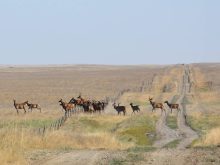Invasion of the lady beetles.
It’s not the best title for a horror movie, but lady beetles did invade thousands of homes across Manitoba last fall.
The infestation was annoying because Asian lady beetles, while nice to look at, do like to bite humans.
The population of lady beetles, or ladybugs, exploded in Manitoba last year, partly because there was a massive population of their favourite snack — soybean aphids.
“People’s houses were full of lady beetles,” said John Gavloski, Manitoba Agriculture entomologist. “They love feeding on soybean aphids and they will consume … about 100 aphids per day.”
Read Also

Bunge’s crop mix is changing
Bunge has predominantly been a soybean processing firm, but that’s about to change after the merger with Viterra with softseed processing and grain merchandising gaining ground.
The summer of 2017 was a nasty season for soybean aphids, as the tiny insects infested nearly every soybean field — meaning they covered more than 2.2 million acres of farmland in Manitoba.
The summer of 2018 is a completely different story.
As of late July, there were no soybean aphids in Manitoba.
“For us to be at the end of July, and have no soybean aphids, that’s late,” said Gavloski, who spoke at Crops-a-palooza, an agronomy learning event held in Portage la Prairie, Man.
In a more normal year, soybean aphids would arrive in early July.
The insects likely don’t overwinter in Manitoba.
Most blow in with southerly winds from the United States.
The aphids are pests for soybeans because they pierce plant tissues and remove the sap, stealing nutrients from growing plants.
It’s difficult to gauge yield losses, but a Manitoba Pulse & Soybean Growers (MPSG) fact sheet suggests that 500 aphids per plant, feeding for 20 days, would decrease yields by seven percent.
That sort of yield loss won’t happen this summer.
If the aphids appear in early August, it’s probably too late to damage this year’s soybean crop.
“Even if they arrive (at) podding, where seeds are growing like crazy… you don’t have to worry about them anymore,” said Cassandra Tkachuk, MPSG production specialist.
Last year’s explosion of lady beetles may explain why aphid numbers are down in 2018. The beetles may have consumed a large percentage of the aphids south of the border, reducing the population that over-wintered in 2017-18.
While soybean aphids are down, grasshoppers prospered in the dry conditions this spring and summer.
“We are seeing a bit of a resurgence. It’s certainly not an outbreak,” Gavloski said.
“There’s been some spraying. Mainly field edge.”















